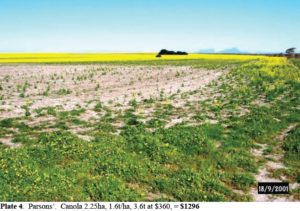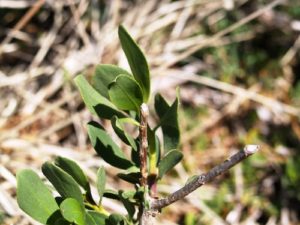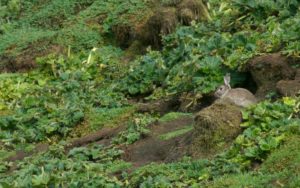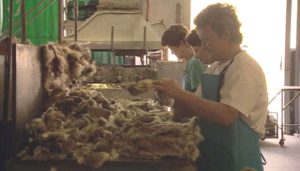Introduction
The European rabbit (Oryctolagus cuniculus) is a serious environmental and agricultural pest throughout Australia. Rabbits can have considerable impacts on farm productivity and native ecosystems, leading to financial loss and environmental devastation1. The community also suffers indirectly, as they might pay higher prices for rabbit-affected commodities (such as wool)2 or bear the loss of ecosystem services at the catchment scale3. Many of these costs cannot be accurately estimated in a financial sense. Where estimates have been calculated, assumptions and figures vary and are highly conservative2,4,5.
It takes less than one rabbit per hectare to prevent the successful regeneration of many native trees and shrubs
Competition and land degradation by rabbits is listed as a key threatening process in Australia4. Rabbits can cause damage by:
- overgrazing native and sown pastures, leading to loss of plant biodiversity and reduced crop yields
- competing with native animals and domestic livestock for food and shelter, increasing grazing pressure and lowering the land’s carrying capacity
- building warrens, causing land degradation and erosion
- preventing or inhibiting the regeneration of native shrubs and trees by grazing
- increasing and spreading invasive weeds3,6
- acting as a food source for introduced predators, which can lead to increased lamb losses and disease prevalence, and a decrease in small mammal diversity1,3,7,8,9.
All of these impacts eventually lead to higher management costs7, loss of productivity6,8, and huge financial losses for Australia’s farmers9, as well as other land managers (eg national parks)7.
Although biological controls (myxoma virus and rabbit haemorrhagic disease virus, or RHDV) have provided ongoing rabbit control for over 60 years with little cost10, they have not eliminated the problem4. The overall loss caused by rabbits to agriculture and horticulture in Australia was recently estimated to be about $217 million per year11.
Management costs and loss of production

Figure 1: Damage to a canola crop caused by rabbit grazing.
Image: from Wheeler et al (2002)12
Rabbit damage and control costs at the property level vary depending on the land use or enterprise, climate and rainfall, and control methods used1, 5 (see table). The cost per rabbit also varies depending on the value of the affected commodity (eg crop type). For example, rabbit damage to high-value crops such as canola might be more financially devastating than damage to lower-value crops (eg lupins, barley), which generate lower returns per hectare12 (Figure 1). The return on investment in rabbit control is greater when high-value commodities or resources are protected from damage.
While the initial costs of rabbit control can be high (eg warren ripping costs are about $10–$20 per warren10), the benefits can be long term. Often costs can be recouped by added livestock or crop production, or minimised by being shared among neighbouring properties using a coordinated approach1. Taking no action against rabbits is likely to result in higher costs in terms of lost production and ongoing damage5.
An estimate of the costs of rabbits to agricultural enterprises*
| Enterprise |
Approximate cost (/rabbit/per year) $ |
| wool |
1.85 |
| store cattle (property bred) |
2.40 |
| trading cattle (grow out for 12 months) |
2.85 |
| stud cattle |
12.90 |
| broccolo (/ha) |
9.90 |
| lettuce (/ha) |
2.35 |
| lucerne (irrigated, /ha) |
6.80 |
| wine grapes (/ha) |
65.60 |
*Production costs, grazing pressure (DSE) and value of product where applicable were taken into account. Adapted from DPI&F (2005)5.
For a wool producer, the cost of grazing competition between sheep and rabbits is a major cost typically measured in terms of dry sheep equivalents (DSEs). In general, about 16 rabbits/ha is equivalent to one DSE, or about 12 rabbits per DSE in higher-rainfall areas1,2. For example, if one sheep is conservatively considered the grazing equivalent of one warren of 12–16 rabbits14, a paddock containing 500 warrens is already bearing the equivalent of 500 grazing sheep, before the paddock is even stocked.
About 16 rabbits/ha is equivalent to one dry sheep equivalent (DSE) or about 12 rabbits per DSE in higher-rainfall areas
Grazing competition between sheep and rabbits can affect wool production by reducing the quality and amount of wool produced per sheep. In central New South Wales, a paddock experiment found that as rabbit density increased, pasture productivity decreased6. Sheep that were not competing with rabbits had a 7.23 kg greater average liveweight after three years, compared with sheep that were competing with a high-density population of 72 rabbits per hectare6,8. Sheep that were not competing with rabbits also produced 21% more greasy wool per head per year8.

Figure 2: Browsing damage caused by rabbits. Note the 45°‘secateur-like’ cuts through the twigs. Image: Brian Cooke
Rabbits also cause extensive losses to forestry and are a potential threat to new tree plantations designed for carbon offset or sequestration benefits1,15. They can graze plants to ground level, preventing regeneration and limiting seedling establishment1. The cost of tree planting programs is often increased because of the need to erect tree guards. In forestry plantations, damage from browsing rabbits can equate to one year’s loss of growth — up to $800/ha at clear-felling. In private forests, rabbit control costs can be as high as $80/ha when trees are vulnerable to damage1.
Environmental impacts
Low-density rabbit populations can cause significant damage to native plants and pastures, suggesting there might be no ‘safe’ level of rabbit density16 (Figure 2). It takes less than one rabbit per hectare to prevent the successful regeneration of many native trees and shrubs16, which are vital for biodiversity and farm productivity. Removal or loss of vegetation makes soils prone to wind and water erosion (Figure 3), which on farms can lead to reduced soil fertility and siltation of dams1,3. These impacts are intensified and particularly evident during and after droughts4.

Figure 3: Vegetation degradation and erosion damage caused by rabbits on world heritage-listed Macquarie Island. Image: Australian Antarctic Division
With declining populations of many small Australian mammal species over the past 200 years, it is possible that rabbits have partially filled an ecological niche3. Rabbit warrens provide refuge for some native species such as echidnas and large reptiles3. However, cats and foxes also use rabbit warrens for shelter and dens for their young, thus helping these predators to persist in hot, arid areas3. Rabbits also eat and disperse viable native plant seeds, performing an important function in the ecosystem3. However, they can also spread weeds and permanently damage native seedlings in the process2,16.
Rabbits as a resource
Rabbits are a commercial resource that provides employment and income, mainly in rural areas9. Wild rabbits are harvested to supply meat for the game and pet meat industries, and skins for the felt hat industry1,4 (Figure 4). Rabbit meat is considered a high-value gourmet product, although the market price depends on consumer acceptance and demand4. Indigenous Australians and recreational hunters also use rabbits as a food source9.
Before RHDV became established, the value of the wild rabbit industry was estimated at about $10 million per year17. The farmed rabbit industry now dominates the supply of rabbits for domestic and overseas consumption, leading to a steady decline in the commercial harvest of wild rabbits9. Although these trades have suffered as a result of fewer rabbits post-RHDV, the benefits of rabbit control to agriculture and the environment far outweigh these losses17.
Estimated costs

Figure 4: Workers process rabbit carcasses at a farmed rabbit processing facility. Image: Australian Broadcasting Commission
Before the release of RHDV, rabbit-induced production losses in the Australian wool industry were about $130 million per year11. It was estimated that reduced rabbit populations as a result of RHDV would increase agricultural production by $600 million annually, including about $300 million for the wool sector, $150 million for cattle, $80 million for cropping and $70 million for sheep meat17. Recent estimates have valued the cumulative benefit of myxomatosis and RHDV to Australia’s pastoral industries at about $96 billion over the last 60 years10. Although RHDV has effectively reduced the impact of rabbits across many parts of Australia, it is unlikely to keep populations down over the long term18,13.
Rabbit populations are now on the rise, potentially putting Australia’s growing carbon-offset industry and agricultural sectors at risk. Because of the high fecundity of rabbits and the damage likely to be caused by subsequent generations7, on-ground management actions — in conjunction with biocontrol — are expected to provide substantial benefits to primary production and biodiversity. The impact of rabbits on agriculture and conservation will continue to grow, unless continuous effort is put into long-term, integrated rabbit control.
Further information
- Williams K, Parer I, Coman B, Burley J and Braysher M (1995). Managing Vertebrate Pests: Rabbits. Bureau of Resource Sciences and CSIRO Division of Wildlife and Ecology. Australian Government Publishing Service, Canberra.
- Vere DT, Jones RE and Saunders GR (2004). The economic benefits of controlling rabbits in Australian temperate pasture systems from the introduction of the rabbit calicivirus disease. Agricultural Economics 30:143-155.
- Cooke BD (2011). The Ecological Impact of Wild European Rabbits Oryctolagus cuniculus (L.) in Mediterranean-like and Arid Climatic Regions of Australia. Unpublished report. Invasive Animals Cooperative Research Centre, Canberra.
- Department of Environment, Water, Heritage and the Arts (DEWHA, 2008). Background Document for the Threat Abatement Plan for Competition and Land Degradation by Rabbits. DEWHA, Canberra.
- Department of Primary Industries and Fisheries Queensland (DPI&F, 2008). Rabbit Control in Queensland: A Guide for Land Managers. DPI&F, Brisbane, Queensland.
- Croft JD, Fleming PJS and Van de Van R (2002). The impact of rabbits on a grazing system in eastern New South Wales. 1. Ground cover and pastures. Australian Journal of Experimental Agriculture 42:909-916.
- Manson A (1998). Identification of Public and Private Benefits from Agricultural Research, Development and Extension: Some Preliminary Results from a Study of the Australia New Zealand Rabbit Calicivirus Disease Program. Paper Presented at the 42nd Annual Conference of the Australian Agricultural and Resource Economics Society, Armidale, New South Wales, 19 January, 1998.
- Fleming PJS, Croft JD and Nichol HI (2002). The impact of rabbits on a grazing system in eastern New South Wales. Sheep production. Australian Journal of Experimental Agriculture, 42:917-923.
- McLeod R (2004). Counting the Cost: Impact of Invasive Animals in Australia. Cooperative Research Centre for Pest Animal Control, Canberra.
- Cooke BD, Chudleigh P, Simpson S and Saunders G (2011). Economic Benefits of the Biological Control of Wild Rabbits in Australia, 1950-2011. Unpublished report, Invasive Animals Cooperative Research Centre, Canberra.
- Gong W, Sinden J, Braysher M and Jones R (2009). The Economic Impacts of Vertebrate Pests in Australia. Invasive Animals Cooperative Research Centre, Canberra.
- Wheeler SH, Lowe TJ and Twigg LE (2002). Crop and Pasture Protection from Rabbits in Native Bush Remnants. Final report to National Feral Animal Control Program. Department of Agriculture, Western Australia.
- Cooke B, Jones R and Gong W (2010). An economic decision model of wild rabbit Oryctolagus cuniculus control to conserve Australian native vegetation. Wildlife Research 37:558-565.
- Mutze GJ (1991). Long-term effects of warren ripping for rabbit control in semi-arid South Australia. Australian Rangelands Journal 13:96-106.
- NSW Department of Primary Industries (DPI, 2007). Ehhh, what’s up with carbon offsets, Doc? Agriculture Today, December 2007. NSW DPI, Orange, NSW.
- Cooke B, McPhee S and Hart Q (2008). Rabbits: A Threat to Conservation and Natural Resource Management. Bureau of Rural Sciences, Canberra.
- ACIL Economics and Policy Pty Ltd (1996). The Economic Importance of Wild Rabbits to Rural Production in Australia. Report prepared for the International Wool Secretariat.
- Saunders G, Kay B, Mutze G and Choquenot D (2002). Observations on the impacts of rabbit haemorrhagic disease on agricultural productive values in Australia. Wildlife Research 29:605-613.
The authors of these documents have taken care to validate the accuracy of the information at the time of writing. This information has been prepared with care but it is provided “as is”, without warranty of any kind, to the extent permitted by law. The views and opinions expressed in this publication are those of the authors and do not necessarily reflect those of the institutions the authors work for or those who funded the creation of this document.














